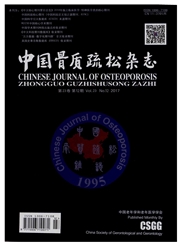

 中文摘要:
中文摘要:
目的分析喝茶组与无喝茶组的生活饮食习惯、生育、疾病因素等基线情况可比性,观察喝茶与汉族绝经后妇女骨密度及骨折发生率的关系。方法随机调查福州常住汉族绝经后妇女623例,剔除30例,完成试验符合要求593例。分组:习惯喝茶(乌龙茶)组112例,无习惯喝茶组481例。专人调查受试者的年龄、职业、文化程度、生活习惯、生育情况、疾病因素和对骨质疏松的认识等,测量身高、体质量,计算体质量指数。用双能X线(DXA)骨密度仪检测腰椎和髋部骨密度。结果593例绝经后妇女中,喝茶组占18.89%,无喝茶组占81.11%。比较两组年龄、职业、文化程度、生活习惯、生育情况、疾病因素和骨质疏松认识等,只有体质量两组比较有统计学意义,P〈0.05,喝茶组体质量明显高于无喝茶组;其他组间比较无统计学意义。体质量作为协变量,协方差分析比较两组骨密度,喝茶组大转子骨密度(0.807±0.117kg/cm^2)高于无喝茶组(0.778±0.117kg/cm^2,F=4.167,P=0.042,),差异有统计学意义,喝茶组Ward’S三角骨密度(0.676±0.130kg/cm^2)高于无喝茶组(0.643±0.138kg/cm^2,F=5.269,P=0.022),差异有统计学意义。绝经后骨折发生率比较:喝茶组13.39%,无喝茶组12.06%,P〉0.05,差异无统计学意义。说明喝茶与汉族绝经后妇女高骨密度明显相关,但与绝经后骨折无相关。结论喝乌龙茶有助于汉族绝经后妇女维持高骨密度。
 英文摘要:
英文摘要:
Objective To analyze the baseline comparability of living and diet habits, fertility, and disease background of women in tea drinking group and non-tea drinking group, and to observe "the relationship between bone mineral density and fracture incidence in tea drinking postmenopausal Ban women. Methods Six hundred and twenty-three postmenopausal Han women living in Fuzhou were randomly investigated. Among those, 30 cases were dropped and 593 cases were qualified and fulfilled the experiment. The women were assigned to tea drinking group ( 112 cases who habitually drank Oolong tea) and non-tea drinking group (481 cases who were not used to drink tea). The age, occupation, education, lifestyle, fertility, disease background, and knowledge of osteoporosis of the participants were investigated by specialists. The height, body mass, and body mass index were measured and calculated. The bone mineral densities of the lumbar vertebra and the hip were measured using dual-energy X-ray absorptiometry. Results Of the 593 postmenopausal women, 18.89% was in tea drinking group and 81.11% was in non-tea drinking group, respectively. Comparing the age, occupation, education, lifestyle, fertility, disease background, and knowledge of osteoporosis, etc. , between the participants in two groups, only body mass was found to be statistically significant ( P 〈 0. 05 ). Body mass in the tea-drinking group was significantly higher than that in non-tea drinking group. The analysis of covariance comparing bone densities across the two groups revealed that the bone densities of the greater trochanteric bone were higher in tea drinkers (0. 807±0. 117 kg/ cm2 ) than those in non-tea drinkers (0. 778±0. 117 kg/em2 , F = 4. 167, P = 0. 042). The difference was statistically significant. The bone density of the Ward' s triangular was higher in tea drinkers (0. 676±0. 130 kg/cm2) than that in non-tea drinkers (0. 643±0. 138 kg/cm2, F = 5. 269, P = 0.022). The difference was statistically significant. The fra
 同期刊论文项目
同期刊论文项目
 同项目期刊论文
同项目期刊论文
 期刊信息
期刊信息
